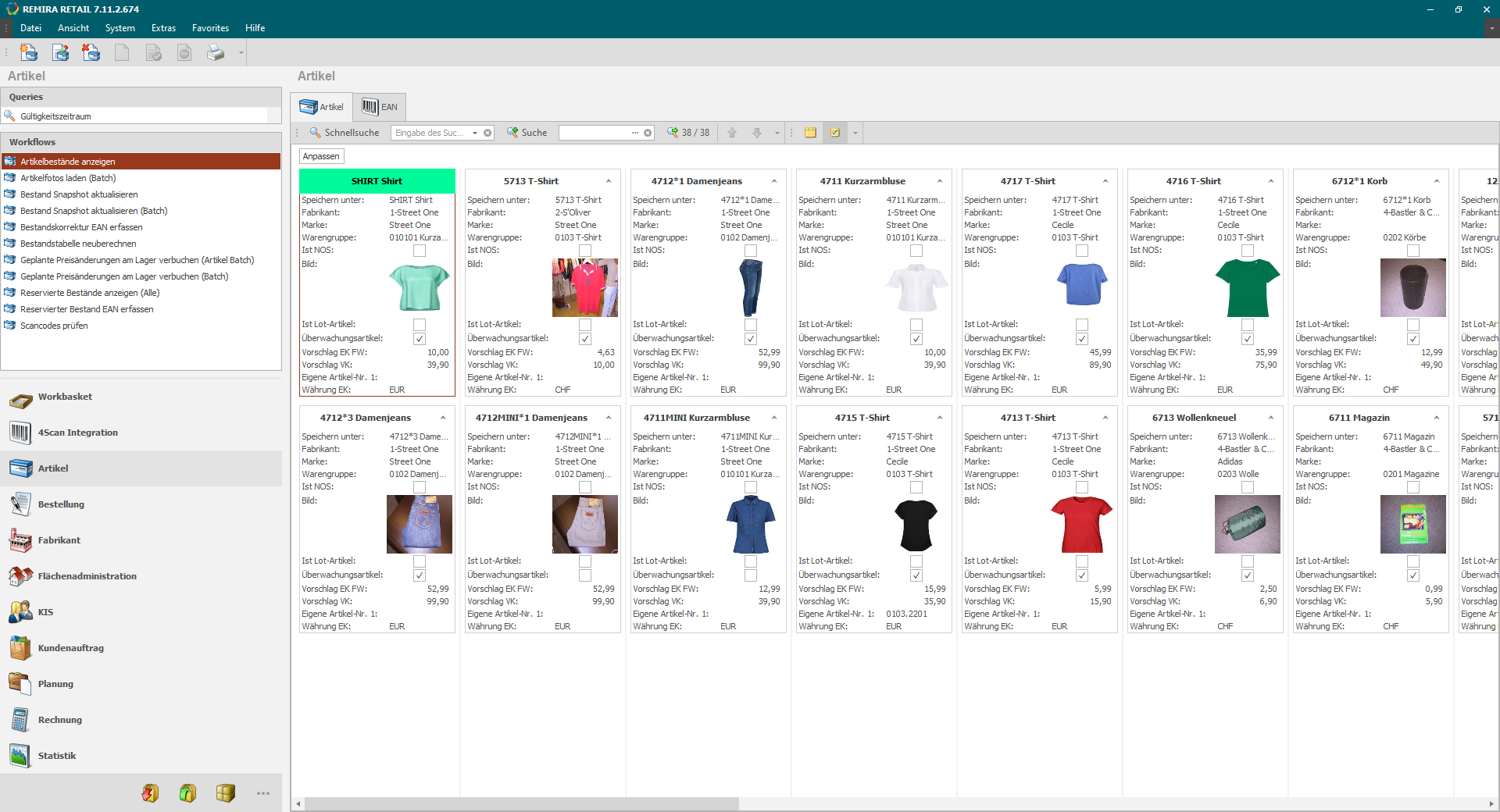Software for merchandise management
Retail companies have to cope with time-consuming planning and administration activities. Merchandise management software automates back-office tasks from planning to distribution of goods, saving time and money. REMIRA offers you an appropriate and proven software solution for merchandise management in retail.
What is an inventory management system?
A merchandise management system is software that ensures that the right goods are in the right place at the right time. Modern merchandise management software therefore manages the supply of goods to sales areas and largely automates the company-wide control of goods movements. This is based on information from the company and defined specifications. The software automatically reorders items that should always be in stock (NOS items = Never Out of Stock) or suggests stock transfers from other stores. A merchandise management system is usually the inventory management system for all item and customer data in the company.
With this orientation, the merchandise management system is close to the classic ERP system, especially as merchandise management systems can also have extensions and take over the tasks of a typical ERP system. In this case, no distinction is necessarily made between the two terms. If the company already has ERP software that has proven itself for various business processes, but does not map merchandise management processes adequately or at all, it may make sense to network the merchandise management system with the existing ERP solution. A merchandise management system can also be connected to other company software via the appropriate interfaces - for example to accounting software, a CRM or an online store. When connected to e-commerce, the merchandise management system transmits item and inventory data to the online store. Conversely, the store system reports the order data back to the merchandise management system. This makes the merchandise management system the central data hub in e-commerce and omnichannel retail.
EDI as an important factor
Manufacturers can use a merchandise management system to centrally map and control the flow of goods across hundreds of areas. There are solutions that offer a high degree of automation.An EDI connection is a prerequisite for certain data transfers. A merchandise management solution should therefore also be able to translate data communication into suitable formats using an EDI converter. The use of EDI (Electronic Data Interchange) in retail also saves time. The EAN barcodes on the packaging are used with the master data sent by suppliers. Invoices from suppliers can also be managed automatically, saving time during invoice verification.
REMIRA's merchandise management system provides you with a powerful system with proven standards and a multitude of effective, state-of-the-art functions. REMIRA's merchandise management solution also offers the most important interfaces for handling central business processes in retail and sales.
.png?width=1920&name=REMIRA-EDI-Alternative-1-_Alex-from-the-Rock-stock.adobe.com-2%20(1).png)
What advantages does merchandise management software offer?
A merchandise management system in the sense of flexible standard software offers both elementary and specialized functions for your retail business. The merchandise management system thus reduces the use of individually programmed software and workarounds in your company. This reduces the error rate in many processes and indirectly leads to more satisfied customers. Lengthy decision-making processes for the distribution of goods are also completely eliminated thanks to the automated processes in the merchandise management system. If, for example, orders are received by the company via the online store, a subjective decision would have to be made as to which store an order should be retrieved from without the corresponding software solutions. When using merchandise management software, this decision is made effectively and quickly by the merchandise management system.
The merchandise management software also supports your purchasing department in planning your merchandise requirements. The function is based on comparative periods from previous years, even with a time delay to the planning period. Even stores for which no empirical values are available are calculated using comparative stores. A data warehouse or BI tool dashboard can also be used to keep an eye on the purchasing limit. Would you like to make a stock transfer for your customers? Then, for example, simply start the goods request in the dedicated module for item stock and trigger the automated stock transfer. Whether NOS items, stock transfers, recalls or replenishment from the central warehouse, a merchandise management system ensures efficient processes and determines the sales potential. With a variety of decision parameters, an inventory management system evaluates within seconds in which of your company's stores, for example, minimum stock levels per item should be higher in order to achieve better sales figures.
Advantages of an inventory management system in retail at a glance
- Placing the right goods in the right place at the right time
- Recording and managing stock
- Management and reordering of NOS items
- Automated processes
- Monitoring of the business process
- Clear company key figures
- Quick evaluation, e.g. sales evaluation, according to various parameters
- Management of goods on different sales areas
- Organization of stores and areas, e.g. via area master sheet
- Real-time data updating
- Integration of EDI
- Connection to an ERP system, online store, accounting, personnel planning, etc.
- Interface for other business software
What functions does merchandise management software need?
Regardless of whether you are a manufacturer or retailer, whether you are introducing a merchandise management system for the first time or want to replace an existing merchandise management solution: You need to find the right ERP system for your retail business. The software solution you choose should offer you many advantages and important interfaces as standard, in line with the best-of-breed principle. We would be happy to conduct a free consultation with you to determine your requirements and provide you with a quote.
Important functions of a merchandise management system
- Merchandise management:to avoid price reductions and thus markdowns
- Merchandise management:suggestions for stock transfer, price changes or reordering
- Workflows: Adaptation to the processes in the company
- Planning: For all stores, based on comparison periods
- Event management:control for relevant situations
- Omnichannel capability: ready for e-commerce thanks to real-time data transfer
You can meet the expectations of your customers with your retail business and expand your merchandise management software to include an online store and other software from other providers. REMIRA's open software solution ensures that other solutions can be easily connected to the core systems and that data is exchanged in real time. Thanks to its modular structure, REMIRA merchandise management is just as good a choice for a single store as it is for companies with single or several hundred branches. For customers with smaller companies, REMIRA also offers a compact merchandise management system as a cloud solution.
Special requirements for merchandise management solutions in fashion retail

A merchandise management system for retail in the fashion industry knows article attributes such as size and color. Reorders of NOS items, the "basics" of the brand, play a major role in this industry. Above all, however, the software supports demanding management tasks in the fashion, lifestyle and sports sectors. The REMIRA merchandise management system makes it possible to place goods where interested customers are by means of targeted stock transfers. This helps to avoid markdowns, as price reductions can be postponed to a later date. The REMIRA software's goods management system creates the conditions for quickly moving goods to the location where they will achieve the highest possible margin. In most cases, EDI processing is already integrated into the system, allowing invoices from suppliers or credit notes to be managed automatically and thus saving time via EDI.The software also provides the company's management with evaluation options with different objectives.
Examples of evaluations with merchandise management
For a short-term income statement (KER), e.g. quarterly, monthly, weekly
- Branch evaluation
- Supplier evaluation
- Material group evaluation
- Stock information
- Information about orders
- Inventory turnover rate (LUG)
- Renner-Penner analysis
- Sell-off rate
- Price markdowns
- Age statistics (goods)
- Discounts
- Season/combination with weather data
- Conversion rate: Customer frequency in combination with vouchers
- Ranking: top suppliers, top customers
- Which (registered) customer buys which brands/sizes/at what times
What are the requirements for introducing an ERP system?
Are you planning to renew your IT landscape in the foreseeable future or are you looking at introducing an ERP solution for the first time? This will make the changeover easier:
- Create an overview of company processes
- Derive requirements for the new software
- Plan internal resources
- Arrange a workshop with the IT provider*
- Involve employees from all departments
- Plan and weigh up processes and risks
- If necessary, have a test system set up*
- Have employees trained who then train colleagues
- Discuss and plan support
*Not required for small companies that use a solution from the cloud as a modular license model that can be installed in just a few hours.

Are you interested in omnichannel commerce software?
Keeping track of different stores and warehouses is becoming increasingly important in the age of omnichannel commerce. We understand this and offer you - whether you are a large or small company - customized solutions that are precisely tailored to your needs.Find out more about our omnichannel commerce software solutions now.
Are you looking for a solution for optimal merchandise management?
Our all-in-one solution automates and optimizes your back office processes and places your merchandise where it sells best. Maintain a constant overview of all current data and processes in your store and create the basis for modern omnichannel retail.
Find out more in our free web session!